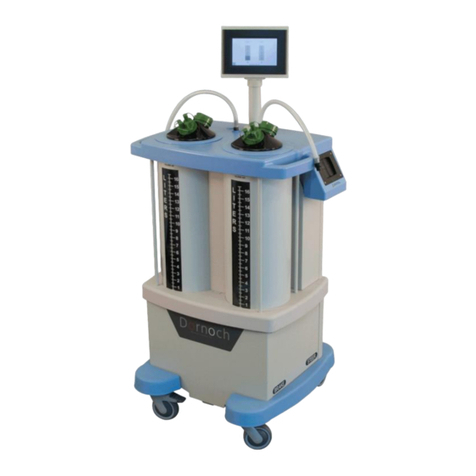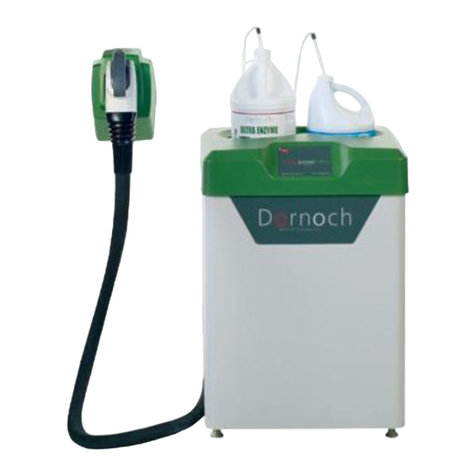
Safety Station Technical Service Manual 2 10/17/2011
GD-99009 Rev. B
Déclarations et avertissements importants
Ce symbole sert à alerter le lecteur en lui procurant des renseignements relatifs à la sécurité et aux précautions à prendre. Lorsqu'il
apparaît sur un dispositif, il renvoie l’utilisateur aux consignes jointes et indique la présence de renseignements relatifs à la sécurité
et aux précautions à prendre. Pour toute question, veuillez téléphoner à Dornoch Medical Systems, Inc. au +1-888-466-6633.
Veuillez lire ce manuel et suivre toutes les consignes avec soin. Les mots AVERTISSEMENT et MISE EN GARDE ont des significations
particulières, qui doivent être étudiées avec soin.
AVERTISSEMENT : La sécurité personnelle du patient et/ou de l’utilisateur peuvent être en jeu. Ne pas tenir compte de
ces renseignements pourrait entraîner des blessures du patient et/ou du personnel de l'hôpital.
MISE EN GARDE : Ces consignes signalent un entretien spécial ou des procédures opérationnelles, comprenant des
indications qui doivent être suivies pour éviter d'endommager le dispositif.
•AVERTISSEMENT : Avant d’utiliser ce système, il faudra lire et comprendre les renseignements inclus dans ce manuel.
L’équipement d’aspiration doit seulement être utilisé par des personnes qui ont la formation adéquate pour utiliser ce type
d'équipement.
•AVERTISSEMENT : Les normes relatives aux pathogènes transmis par voie sanguine et fournies par OSHA
(Occupational Safety and Health Association), l’agence américaine pour la santé et la sécurité au travail, exigent que tout
personnel exposé à des « matières à risque infectieux » porte l’équipement de protection individuel adapté.
•AVERTISSEMENT : Pour éviter le risque de choc électrique, cet équipement doit être connecté à une prise électrique
protégée par une mise à la terre.
•AVERTISSEMENT : Vérifiez que toutes les portes d’accès sont immobilisées et en place, avant d’utiliser l’appareil.
•AVERTISSEMENT : Seul le personnel d'entretien autorisé a le droit d’ouvrir les portes d'accès se trouvant sur cet
équipement. L'utilisateur n'a pas besoin d'accéder à ces lieux pour utiliser l'appareil.
•AVERTISSEMENT : Utilisez uniquement les accessoires approuvés par Dornoch Medical Systems, Inc. Ne raccordez pas
au système des dispositifs qui ne sont pas conçus ni spécifiés pour l'utilisation avec ce système.
•AVERTISSEMENT : Aucune pièce se trouvant à l'intérieur de l'appareil ne peut être entretenue ou réparée par l'utilisateur.
Contactez l'assistance à la clientèle de Dornoch Medical Systems, Inc. en cas de problème.
•AVERTISSEMENT : L'appareil est destiné à l'utilisation au sein de l'hôpital et/ou du centre chirurgical. Le TPSS n'est pas
destiné à l'utilisation sur le terrain ni au transport sur le terrain. L'appareil doit uniquement être déplacé par du personnel
formé ; il n'est pas conçu comme dispositif portatif.
•AVERTISSEMENT : Pas d'utilisation sur plans inclinés.
•AVERTISSEMENT : Cet appareil fonctionne avec de la javel et un produit enzymatique. Lorsque vous remplissez les
réservoirs, veillez à bien porter l'équipement de protection individuel approprié.
•AVERTISSEMENT : Cet équipement ne convient pas à une utilisation en présence de mélanges anesthésiant inflammables
avec air, oxygène ou protoxyde d'azote. Il n'est pas adapté pour l'utilisation avec un équipement AP ou APG.
•AVERTISSEMENT : Les températures d'eau chaude supérieures à 120 0F risquent d'endommager l'appareil.
•Il n'existe pas de risque important connu d'interférence réciproque posé par la présence de cet équipement ou par son
fonctionnement, que ce soit dans les blocs opératoires ou dans d’autres zones, en cas d'utilisation au cours d'investigations
et/ou de traitements spécifiques.
•Il n'existe pas d'interférences électromagnétiques potentielles connues, ni d’autres interférences potentielles connues entre
cet appareil et d'autres dispositifs situés et/ou utilisés dans la zone des blocs opératoires.





























